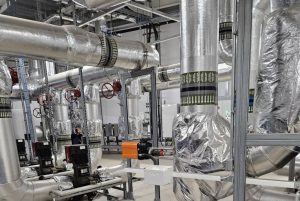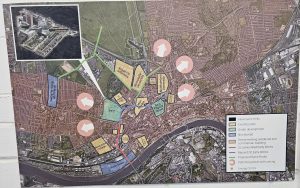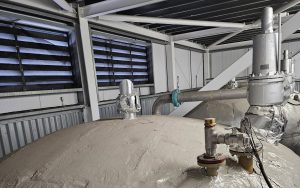
Our team at Climate Action Newcastle recently had the privilege of visiting the Helix Energy Centre on July 24, 2025, an insightful event hosted by Newcastle City Council. It was a fantastic opportunity for us, and other local stakeholders, to delve deeper into the city’s Heat and Energy Strategy and explore how we can collectively accelerate Newcastle’s decarbonisation efforts.

The Vision of Newcastle Helix
The Helix site itself is a beacon of sustainable urban development. It’s designed as a vibrant community where hundreds of researchers, businesses, and progressive homeowners live and work side-by-side, united by one purpose: to help families, communities, and cities around the world live healthier, longer, smarter, and easier lives—in short, to live better. This innovative district, with its stunning architecture, public spaces, and easy access to the city centre, is a living laboratory for new approaches to sustainable urban development. It’s also home to the Newcastle Urban Observatory’s City Heartbeat, a leading open data sensing network that monitors everything from air quality to traffic flows, providing real-time data to back up decision-making for a smarter city.
Our Engaging Day
The day’s agenda provided a comprehensive and highly informative experience:
- We began with a warm welcome and an introductory address from David Trousdale, Principal Advisor – Climate Change, Deputy Chief Executives Office, Newcastle City Council , which set a clear and urgent tone for the discussions ahead.
- Central to our visit was the site tour of the District Energy Centre at the Helix. This centralised energy system for the entire 24-acre site is not only a hub for exploring emerging energy technologies but also a crucial component of Newcastle’s decarbonisation efforts. Seeing this large-scale heat network in action truly brought to life the potential of low-carbon energy infrastructure. During this visit, we were shown a detailed map illustrating the Energy Centre’s current operations and the exciting potential for future expansion across the city, including details of the well-progressed plan to incorporate Newcastle College into the network, a move that will notably remove the need for replacing numerous inefficient boilers across their extensive site.
- We participated in a session that clearly articulated why decarbonising heat and energy is so crucial for our city’s future, reinforcing the urgency of the climate crisis.
- Crucially, we had the chance to provide our input directly into the developing Heat and Energy Strategy through both a survey and a dedicated discussion session. This commitment to public engagement was much appreciated.
- The session concluded with a helpful summary, tying together the day’s insights.
What We Learned: Key Takeaways from the Council’s Briefing
The Council shared vital data and context that underscored the scale of the challenge and the targeted approach needed:
Understanding Newcastle’s Emissions Picture We learned that a significant 64% of Newcastle’s total city-wide emissions are energy-related. This breaks down into:
- Domestic emissions: 33% (our homes)
- Commercial emissions: 26% (retail, offices, hospitals)
- Industrial emissions: 5% (factories) This clearly indicates that tackling energy consumption across all sectors is absolutely paramount for us to achieve our Net Zero 2030 target.
Insights into Domestic Emissions The Council highlighted that our homes’ heating and hot water are the primary drivers of domestic emissions, with natural gas still dominating as the fuel source for 73% of residential consumption. While it was positive to hear about an 8% reduction in overall domestic emissions since 2019, a concerning point was the simultaneous 1% increase in natural gas consumption. This suggests that while energy price rises might have led to reduced consumption, the transition to low-carbon heating technologies is still progressing slowly. The charts presented visually confirmed that space heating is the biggest contributor, with natural gas being the predominant cause of emissions.
We appreciated the Council’s pragmatic approach to different housing sectors: recognizing their ability for direct action in social housing (where they are the landlord) and their focus on engaging, influencing, and encouraging private homeowners and the private rented sector through various initiatives, including planning.
Addressing Commercial Emissions For commercial emissions (from heating and lighting businesses), we learned that retail, industrial offices, and major hospitals are the largest contributors. It was encouraging to hear that commercial emissions have seen a positive 14% reduction (47,894 tCO2e) since 2019. This progress, we were told, aligns with the UK Government’s Industrial Strategy. The data showed that retail and offices are major emitters, heavily reliant on natural gas and electricity, while industrial emissions also utilize “Other Fuels.”
Decarbonisation Tools and Newcastle’s Proactive Steps The session outlined key tools for decarbonising energy, which the city is actively pursuing:
- Heat Networks: We saw first-hand the operation of the District Energy Centre, and learned about the significant expansion of the Helix Energy Centre heat network. This was vividly demonstrated on the map, highlighting areas of “potential growth with energy.”
- Air Source Heat Pumps: Being supported through various low-carbon technology initiatives.
- Solar and Battery Storage: With the Council exploring widespread rooftop solar installations across the city.
- Small Scale Wind: Also a viable option for local renewable energy generation.
We were informed about further concrete actions, including the £2.2 million Warm Homes Local Grant aimed at decarbonising around 200 properties, and ongoing work to decarbonise social housing, such as the impactful project at Shieldfield Towers. We were particularly excited to hear that mine water will soon be integrated into the system, further reducing the carbon footprint of The Helix and the many other buildings and businesses powered by this innovative District Energy Centre.
What We Discussed: Our Opportunity to Contribute
The interactive discussion segment was a crucial part of the day, allowing us to voice our perspectives. The key questions posed to us were:
- What would we like to see included or emphasized in Newcastle’s Energy and Heat Strategy?
- What specific actions does Newcastle City Council need to take to promote low-carbon technologies in the energy and heat space?
- What do our city partners need to do to support the promotion of low-carbon technologies?
Our members actively participated, offering valuable insights and suggestions that we hope will help strengthen the Council’s strategy.
We left the Helix Energy Centre feeling more informed and encouraged by the Council’s commitment and the actions already underway. We look forward to continuing our collaboration and challenging Newcastle City Council and all city partners on this vital journey.

